Definition of refractory migraine and their evolution
IF 0.4
Q4 CLINICAL NEUROLOGY
引用次数: 0
Abstract
The term ‘refractory migraine’ (RM) is commonly used in clinical settings; however, it is not recognized in the International Classification of Headache Disorders, third edition. A growing need for a shared definition of refractoriness has been highlighted by a multidisciplinary expert group. Although definitions for RM currently exist, the key parameters for the definition of refractoriness (e.g., unresponsiveness to treatment, high frequency, severe disability, or all of these features) remain contentious. Thus, a consensus on the definition of RM is crucial.Calcitonin gene‐related peptide (CGRP) is a neuropeptide that plays an important role in migraine pathophysiology and is a target for migraine preventive therapies. Monoclonal antibodies targeting the CGRP (i.e., galcanezumab, fremanezumab, and eptinezumab) and its receptor (erenumab) have shown consistent efficacy for migraine prophylaxis with excellent safety profiles. Their effect on refractory cases has also been reported, offering promise to the many patients who have not found relief with existing treatments. Therefore, we anticipate a paradigm shift in migraine treatment.Following the widespread use of monoclonal antibodies targeting the CGRP and its receptor, the European Headache Federation proposed a definition for two subsets of difficult‐to‐treat migraine—resistant and refractory migraine—that considers both the frequency and disability caused by single and frequent attacks.We expect that this definition will help resolve previous conflicts that have limited the use of earlier definitions.难治性偏头痛的定义及其演变
难治性偏头痛"(refractory migraine,RM)一词在临床上被广泛使用,但《国际头痛疾病分类》(International Classification of Headache Disorders)第三版并未承认这一术语。一个多学科专家组强调,人们越来越需要一个共同的难治性定义。尽管目前已有关于难治性头痛的定义,但对难治性定义的关键参数(如对治疗无反应、高频率、严重残疾或所有这些特征)仍存在争议。降钙素基因相关肽(CGRP)是一种神经肽,在偏头痛病理生理学中起着重要作用,也是偏头痛预防疗法的靶点。针对 CGRP(即 galcanezumab、fremanezumab 和 eptinezumab)及其受体(erenumab)的单克隆抗体已显示出对偏头痛预防的一致疗效和良好的安全性。它们对难治性病例的疗效也有报道,这为许多无法通过现有疗法缓解症状的患者带来了希望。随着针对CGRP及其受体的单克隆抗体的广泛应用,欧洲头痛联盟提出了难治性偏头痛和难治性偏头痛两个子集的定义,该定义同时考虑了单次和频繁发作的频率和造成的残疾。
本文章由计算机程序翻译,如有差异,请以英文原文为准。
求助全文
约1分钟内获得全文
求助全文

 求助内容:
求助内容: 应助结果提醒方式:
应助结果提醒方式:


